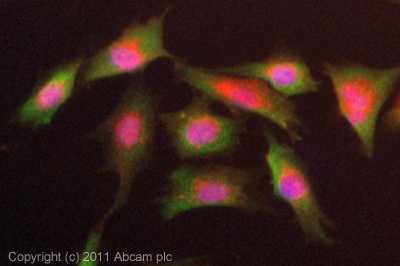
All lanes : Anti-SEMA4A antibody (ab70178) at 1/500 dilutionLane 1 : Extracts from COS-7 cellsLane 2 : Extracts from Jurkat cellsLane 3 : Extracts from COS-7 cells with immunizing peptide at 10 µgLysates/proteins at 30 µg per lane.
![SEMA4A was immunoprecipitated using 0.5mg Jurkat whole cell extract, 5µg of Rabbit polyclonal to SEMA4A and 50µl of protein G magnetic beads (+). No antibody was added to the control (-). The antibody was incubated under agitation with Protein G beads for 10min, Jurkat whole cell extract lysate diluted in RIPA buffer was added to each sample and incubated for a further 10min under agitation.Proteins were eluted by addition of 40µl SDS loading buffer and incubated for 10min at 70oC; 10µl of each sample was separated on a SDS PAGE gel, transferred to a nitrocellulose membrane, blocked with 5% BSA and probed with ab70178.Secondary: Mouse monoclonal [SB62a] Secondary Antibody to Rabbit IgG light chain (HRP) (ab99697).Band: Band: 90kDa: SEMA4A.](http://www.bioprodhub.com/system/product_images/ab_products/2/sub_4/28100_SEMA4A-Primary-antibodies-ab70178-3.jpg)
SEMA4A was immunoprecipitated using 0.5mg Jurkat whole cell extract, 5µg of Rabbit polyclonal to SEMA4A and 50µl of protein G magnetic beads (+). No antibody was added to the control (-). The antibody was incubated under agitation with Protein G beads for 10min, Jurkat whole cell extract lysate diluted in RIPA buffer was added to each sample and incubated for a further 10min under agitation.Proteins were eluted by addition of 40µl SDS loading buffer and incubated for 10min at 70oC; 10µl of each sample was separated on a SDS PAGE gel, transferred to a nitrocellulose membrane, blocked with 5% BSA and probed with ab70178.Secondary: Mouse monoclonal [SB62a] Secondary Antibody to Rabbit IgG light chain (HRP) (ab99697).Band: Band: 90kDa: SEMA4A.

Immunohistochemistry analysis of paraffin-embedded human brain tissue using ab70178 at 1/50-1/100 dilution.Left image un-treated.Right image treated with immunizing peptide.

ICC/IF image of ab70178 stained SKNSH cells. The cells were 4% formaldehyde (10 min) and then incubated in 1%BSA / 10% normal goat serum / 0.3M glycine in 0.1% PBS-Tween for 1h to permeabilise the cells and block non-specific protein-protein interactions. The cells were then incubated with the antibody (ab70178, 10µg/ml) overnight at +4°C. The secondary antibody (green) was ab96899 Dylight 488 goat anti-rabbit IgG (H+L) used at a 1/250 dilution for 1h. Alexa Fluor® 594 WGA was used to label plasma membranes (red) at a 1/200 dilution for 1h. DAPI was used to stain the cell nuclei (blue) at a concentration of 1.43µM.

![SEMA4A was immunoprecipitated using 0.5mg Jurkat whole cell extract, 5µg of Rabbit polyclonal to SEMA4A and 50µl of protein G magnetic beads (+). No antibody was added to the control (-). The antibody was incubated under agitation with Protein G beads for 10min, Jurkat whole cell extract lysate diluted in RIPA buffer was added to each sample and incubated for a further 10min under agitation.Proteins were eluted by addition of 40µl SDS loading buffer and incubated for 10min at 70oC; 10µl of each sample was separated on a SDS PAGE gel, transferred to a nitrocellulose membrane, blocked with 5% BSA and probed with ab70178.Secondary: Mouse monoclonal [SB62a] Secondary Antibody to Rabbit IgG light chain (HRP) (ab99697).Band: Band: 90kDa: SEMA4A.](http://www.bioprodhub.com/system/product_images/ab_products/2/sub_4/28100_SEMA4A-Primary-antibodies-ab70178-3.jpg)

